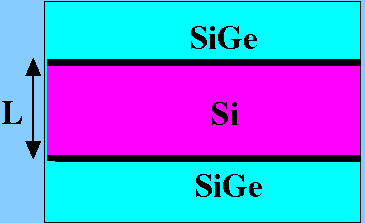Valley-Splitting in Si/SiGe heterostructures
Valley Splitting can be modeled in effective mass theory by a delta-potential in both interfaces of a
quantum well:


as a result, the +k and -k states interact and split in energy.
T2 and T1 Processes in Silicon Heterostructures
We study different relaxation and decoherence processes in Si quantum dots (QDs) for
quantum computing (QC) applications. The 2-DEG is formed in a Si/SiGe modulation-doped heterostructure,
where further confinement is achieved by applying top-gate negative voltages.
We then study different processes, as indicated below: T1, for single spin-flip,
TST, for the time it takes a prepared triplet state to relax to a singlet, or
coherence time, T2, all schematically described below:
The T1-type mechanisms are the hyperfine coupling and spin-orbit coupling, and sub-sequent phonon
emission ensures energy conservation.
Hyperfine Coupling with 29Si:
The main source of decoherence in such structures occurs via the nuclei of the 29Si isotope.
The hyperfine coupling (HC) determines the strength of the electron-nuclear spin interaction:
Spin-Orbit Coupling (SOC) in Si Nanostructures
In Si quantum wells, the Rashba and Dresselhauss terms can be present.
The pink and the blue arrows represent, respectivelly, the direction the spin would have in k
space.
To discriminate the effects of the both different contributions, one can study SOC over the
[110] (where both contributions cancell partially each other) and the [1-10] (where both terms
have the same direction):
For the Effective Mass Theory(EMA), we include SOC as in valley-splitting theory: as a
"delta-" potential in both interfaces of the quantum well, and obtain that both valleys split further in
energy, by different ammounts.
Two terms come into play: the intra-valley (magenta) and the inter-valley (green)
SOC. As a result, the structure of both valleys can be different, as shown in the last part of the figure.
It is important to note that, although both subbands split due to SOC, the total spin averaged over all
directions in k-space is 0, ie: there is still time reversal.
Phonon Emission
Phonon emission in T1 or TST processes ensures energy conservation. The electron-phonon
interaction occurs via a deformation potentaial due to strain, for which the Hamiltonian looks like:

Electronic Structure in Composite Channels
|